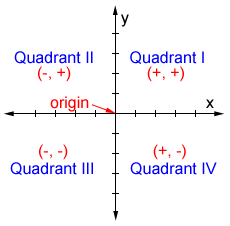Quadrant
In geometry, a quadrant is one of the four sections of a rectangular coordinate plane. The four quadrants make up the area contained by the x- and y-axes and are labeled I through IV, starting in the upper right quadrant and going counterclockwise, as shown in the figure below.

What is a quadrant
A quadrant is one of the four infinite sections defined by the x- and y-axes. Together, the 4 quadrants make up the coordinate plane.
- Quadrant I - the first quadrant is in the upper right hand corner of the coordinate plane. The x- and y-values in quadrant I are all positive (+).
- Quadrant II - the second quadrant is in the upper left hand corner of the coordinate plane. The x-values in quadrant II are negative (-) and the y-values are positive (+).
- Quadrant III - the third quadrant is in the bottom left hand corner of the coordinate plane. The x- and y-values in quadrant III are all negative (-).
- Quadrant IV - the fourth quadrant is in the bottom right hand corner of the coordinate plane. The x-values in quadrant IV are positive (+) and the y-values are negative (-).
Signs of x and y values in a quadrant
The signs of coordinates of any point plotted in a particular quadrant are the same. A point cannot lie in both a quadrant and on an axis. Points that lie on either axis have one coordinate that is 0, which is neither positive nor negative. The diagram below shows the signs of coordinates in different quadrants.

Example:
Determine which quadrant each of the following points are located in. A: (2, 2); B: (-3, 1); C: (-1, -2); D: (3, -4).

Point A is in quadrant I since its coordinates are (+, +).
Point B is in quadrant II since its coordinates are (-, +).
Points C is in quadrant III since its coordinates are (-, -).
Point D is in quadrant IV since its coordinates are (+, -).
Plotting points in quadrants
In the Cartesian coordinate system, points are defined by the x- and y-axis and are represented by an ordered pair, (x, y). The sign of x and y determine which quadrant the point will lie in. The value of x and y determines the number of units along the x- or y-axes from which the given point lies. Also, note that the origin does not lie in any quadrant since it is located at (0, 0). Refer to the table below, which summarizes the sign of the x- and y-coordinates in each quadrant:
| Quadrant | x-coordinate sign | y-coordinate sign |
|---|---|---|
| I | + | + |
| II | - | + |
| III | - | - |
| IV | + | - |
As an example, given the point (-2, 1), we know that the point lies in quadrant II, so we count 2 units left on the x-axis and 1 unit up to locate the point in the coordinate plane.
Sign of trigonometric functions
The signs of the three basic trigonometric functions, sin, cos, and tan, vary based on which quadrant they are in. The sign of each trigonometric function in each quadrant can be determined using the signs of the coordinates along with basic trigonometric relationships. The diagram below shows the signs of these functions in different quadrants.

Did you know?
The first part of the word "quadrant" is from a Latin root meaning four.
A popular name for an all-terrain vehicle (ATV) is "quad," named for its four large tires.

Other words based on the same root include: quadrilateral, quadruplets, quadrillion.
